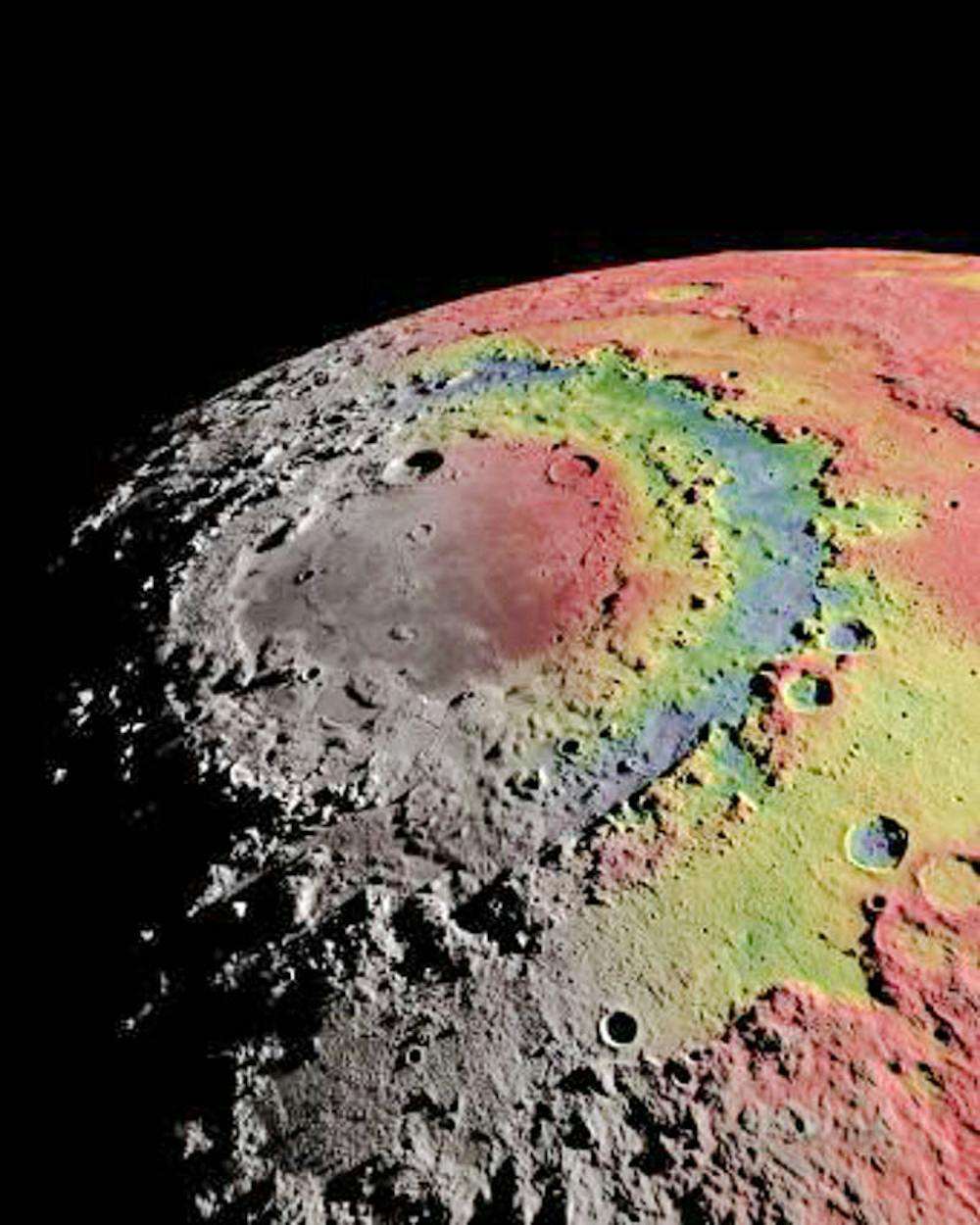Two studies written by University professors that used gravity field data to analyze the structure and formation of the Moon’s Orientale multiring basin were published in the journal Science.
One paper, which focused on modeling the development of the transient crater after impact from what was most likely an asteroid colliding with the Moon’s surface, was led by Brandon Johnson, assistant professor of earth, environmental and planetary sciences.
Both Johnson and James Head PhD’69, professor of geological sciences, were co-authors on the other paper, which analyzed the subsurface structure of the basin’s rings in detail. The second paper, led by Maria Zuber ScM’83 PhD’86 ScD’08, professor of geophysics and vice president for research at the Massachusetts Institute of Technology, also estimated the diameter of the transient crater, which eventually collapsed and gave way to the multiring formation of Orientale. The study found the diameter of the transient crater to be between 320 and 460 kilometers.
Ross Potter, a postdoctoral research associate, previously approximated a diameter of Orientale that aligned with this newer measurement, wrote David Kring, senior staff scientist at the Lunar and Planetary Institute, in an email to The Herald.
Previous estimates of the transient crater’s diameter varied widely — different approximations suggested sizes in line with each of the basin’s rings, according to Zuber’s study. Previously researchers only had photographs and topographical data available to them, said Teemu Öhman, earth and planetary scientist at the Arctic Planetary Science Institute. Compared to earlier theories, these new analyses are much more “believable,” he added.
These articles rely on data collected by the National Aeronautics and Space Administration’s Gravity Recovery and Interior Laboratory mission, which mapped the gravity signatures of this area on the Moon. The data were collected by two spacecrafts flying near the Moon’s surface that measured the distance from one to the other with great precision, Johnson said. As spacecrafts approach areas with greater mass, “you can measure the extra tug of that material,” he added.
The GRAIL data effectively works like an X-ray machine, Head said, revealing the subsurface structure of the Moon. “I’ve always been impressed with how people can do various types of X-rays of Renaissance paintings to distinguish different layers of paint and not only see the way the artist composed it, the brush strokes and overlaying, but sometimes even find another painting underneath,” he added. “It’s the same sort of thing. You can decipher the sequence and the structure by using the GRAIL data.”
“The GRAIL data is magnificent,” Öhman said. “It has truly revolutionized our understanding.”
Johnson noted that these data-based techniques could be applied to other structures on the Moon and potentially aid in understanding the temperatures of the Moon throughout history. This kind of analysis could even be used on other planets to possibly determine the thicknesses of ice shells, he added.
Hopefully, gravity data for Mars will be available in the future, Head said.
This kind of study could have implications for the earth as well, Johnson said. For ancient planets, these impacts were a significant driver of change. In early times, they might have made it challenging for life to take root, “but also, by generating pore space in the crust and hydrothermal systems, they might have made refugia for life as well,” he added.
Head has been involved with lunar geology studies since working on his PhD and wrote his first paper on Orientale in 1974. He then worked for NASA to train astronauts for the Apollo missions before returning to Brown. “After over 40 years of work on this thing, it’s absolutely amazing that we’re able to not only see the substructure, but develop a computer model,” Head said.
The initial impact that created the crater sent pieces flying away from the site, Johnson said. Most of the debris fell relatively near the basin, but “some of it (was) ejected at above escape velocity,” he added.
The projectile was likely about the size of Rhode Island, Head said.
The “bowl-shaped” transient crater collapsed under the force of gravity, like the closing of an opening created by tossing a rock into the water, Johnson said. Then the warm, weak mantle flowed in quickly and pulled the cooler material of the crust along with it, breaking it into blocks. The formation of the two outermost rings were part of this “inward collapse flow,” he added.
“If you throw a rock into the Narragansett (Bay), you’ll also see a big jet come out after,” Johnson said. Similarly, the collapse flow produced a central uplift, which then collapsed and pushed material outward to form the Inner Rook ring.
The rings finished forming after 50 minutes, and there was very minimal movement after three hours, Johnson said.
The basin formation was modeled using a physics code called iSALE, which was created to study processes like impact cratering. It “tells us how material moves and deforms under different stresses,” Johnson said. After inputting information on the Moon’s appearance, the planet’s temperature and structure and the size of the impactor, iSALE takes about a month and a half to calculate the formation of the crater, he added.
But iSALE is limited in that it only constructs models of vertical impacts, Öhman said, which are not frequently found in nature. The model also does not account for asymmetry, since it produces visuals that depict only a slice along one radius of the formation, Johnson said.
“The team’s gravity analysis of the Orientale Basin will be the case study around which analyses of multi-ring basins throughout the Solar System will pivot,” Kring wrote. “It is a true benchmark in impact cratering studies.”
“This is more or less the golden age of space exploration,” Öhman said.





